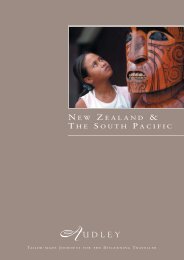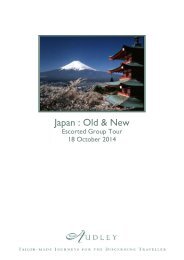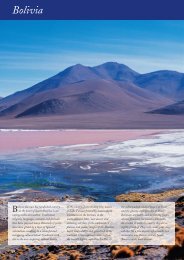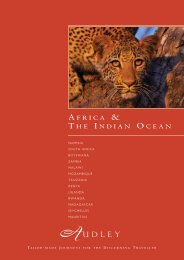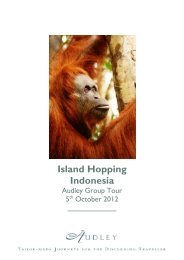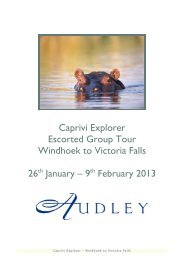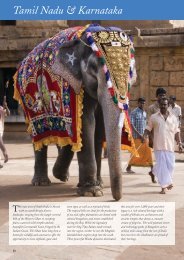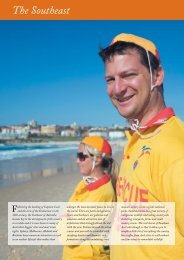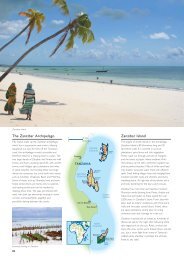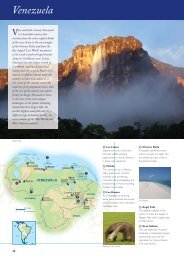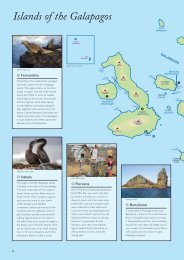Svalbard (Spitsbergen) - Audley Travel
Svalbard (Spitsbergen) - Audley Travel
Svalbard (Spitsbergen) - Audley Travel
- No tags were found...
You also want an ePaper? Increase the reach of your titles
YUMPU automatically turns print PDFs into web optimized ePapers that Google loves.
<strong>Svalbard</strong> (<strong>Spitsbergen</strong>)Littered with towering, jaggedcliffs, ancient ice-caps andglaciers sweeping magnificently downto the sea, the Norwegian archipelagoof <strong>Svalbard</strong> is simply stunning.This mesmerising region, morecommonly known by the name of itslargest island, <strong>Spitsbergen</strong>, is abreathtaking place where walruswallow on the beaches and whalesbreach in the icy seas. However, themain attraction for many visitors isthe fact that over 3,000 polar bearsare believed to live here – on the land,on the edges of the ice and swimmingin the surrounding seas. Sightings ofthese fearless, fearsome and fastanimals will be one of the highlightsof your Arctic adventure. Exploringhere in the summer when thearchipelago just about frees itself ofthe sea ice, and the magnificentscenery and wildlife basks in 24-hourdaylight, is truly unique.Beluga whaleKrossfjordenKongsfjordenPrinsKarlsForlandRaudfjordenLiefdefjordenNy-Alesund2Van KeulenfjordenWijdefjorden3LONGYEARBYENBarentsburgBellsundLaagoya1Hinlopen StraitKappFanshaweSPITSBERGENStorfjordenPhippsoyaNORDAUSTLANDETBarentsoyaEdgeoyaK O N GSVALBARD(NORWAY)KvitoyaK A R L S L A N D0 30 miles0 48 kilometresPolar bearsSpotting one, or hopefullyseveral, will always bemomentous.Beluga whalesSee the heartbreaking piles ofskulls from the whaling days inVan Keulenfjorden, then rally ata possible sighting of thesegraceful creatures swimmingbefore you now that theirnumbers have recovered.1 Hinlopen StraitAt Alkefjellet sheer cliffs rise fromthe clear waters and teem withthousands of nesting Brunnich’sguillemots rearing their young.2 Ny-AlesundThe world’s northernmostcommunity is a formermining village and now animportant international Arcticresearch centre.3 LongyearbyenA fascinating outpost with cosybars and informative museums,great for exploring before youboard your boat.Hornsund10Brunnich’s guillemots
<strong>Svalbard</strong><strong>Svalbard</strong> is a Viking word meaning ‘cold coast’and is the official name for the whole archipelagowhich is believed to have been first discoveredby the Vikings in the 12th century. <strong>Spitsbergen</strong>,which is the name of the largest island, means‘pointed mountains’ in Dutch and was given thisapt moniker by Dutch explorers at the end of the16th century. These names do well to sum up thefeel of this, the most northerly part of Norway’sterritory and a land halfway between mainlandEurope and the North Pole itself. Although thescenery varies throughout the archipelago, jagged,craggy mountains cleaved by creaking glaciersthat spill into the icy sea will set the backdrop foryour adventure.<strong>Svalbard</strong>’s permanent population of approximately2,500 is split between the hub of Longyearbyen,the Russian mining community at Barentsburg,and the research community of Ny-Alesund.Two-thirds of the land is protected as a nationalpark and only 10% has vegetation. Pack ice hemsthe archipelago in for much of the year and thesun sets for good in the winter. However, in thesummer months the sun never sets and thewildlife thrives.Longyearbyen<strong>Spitsbergen</strong>A colourful and modern town that snakes up avalley from Istfjord, Longyearbyen was largelyrebuilt after being shelled during World War II.It is here, in the administrative capital of <strong>Svalbard</strong>on <strong>Spitsbergen</strong>, that you will arrive and thenboard your expedition vessel, but before doingso it is fascinating to spend some time exploring.Snowmobiles are parked outside houses in placeof cars, no one leaves town without a rifle onthem, and you can eat your evening meal watchinga reindeer grazing outside.The world’s most northerly settlement is Ny-Alesund, an international research communitythat was formerly a mining village and was servedby the world’s most northerly railway which isthere to see today. Also here is the anchoringmast used by Roald Amundsen and UmbertoNobile on their expeditions to the North Pole byairship. In the far north of the island of <strong>Spitsbergen</strong>Krossfjorden, <strong>Spitsbergen</strong>lies Hinlopen Strait where the mesmerising cliffsof Alkefjellet play host to thousands of nestingBrunnich’s guillemots. In the south, the dramaticfjord of Hornsund is renowned for its glacierfronts, icebergs and imposing mountains, whileBellsund has a gentler, lusher landscape, once arich picking ground for hunters and trapperswhose tools and shelters remain to this day.Other islandsNordaustlandet, the largest island in the north of<strong>Svalbard</strong>, is a nature reserve almost entirelycovered by a huge ice-cap. This is the real HighArctic, with a harsher climate than the south butgreat wildlife viewing opportunities including seal,walrus and whale sightings. The easterly island ofBarentsoya is a good place for spotting polarbears, as they swim or walk over the sea ice fromthe denning area of Kong Karls Land, which isoff-limits to visitors. Further south is Edgeoya,home to prolific birdlife and herds of reindeer.Reindeer<strong>Audley</strong> in <strong>Svalbard</strong>Visiting <strong>Svalbard</strong> is the ‘classic’ Arctic cruiseexperience: it is easy to get to theembarkation point, the seas are calm, cruisescan be just a week long, you will more thanlikely see polar bears, and the scenery isstunning. Getting to Longyearbyen, the tinysettlement on the island of <strong>Spitsbergen</strong> whereyou will board your vessel, is simple: you canfly there in a day via Oslo. The cruises aroundthis archipelago vary in length between oneand two weeks: some have the simple focusof providing polar bear sightings and willconcentrate their itinerary around the areaswhere they are most commonly sighted,while others attempt to circumnavigate theentire island of <strong>Spitsbergen</strong>, and some visitthe more remote and isolated islands. Theexpedition boats vary in size, comfort andfacilities, and are detailed on pages 32 to 38of this brochure.Polar bear warningFind out moreFor suggested itineraries and practicalinformation about travel in the Arctic, pleasesee pages 14-15 and 18-19.%www.audleytravel.comInteractive maps and features,further suggested itineraries,accommodation, climate informationand articles written by our specialists.Discuss your plans with our Arcticspecialists 01993 838 652Arctic 11
Polar bearsIn <strong>Svalbard</strong> it is said that there are more polarbears than humans and the vast majority ofcruises here encounter at least one of thesemagnificent creatures. But the Arctic climateand environment are changing and this is causingdifficulties for the bears. They prowl the edge ofthe sea ice looking for seals, their main prey, buteach year the ice is melting more quickly, earlierand to a larger extent making it increasingly hardfor the bears to hunt. Possibly the most solitaryanimals in the world, males and females onlycome together to mate or if there is a large killor food source with enough meat to sustainmore than one bear. Male polar bears generallyleave their mother and start to roam alone fromabout the age of two. Female bears breed everytwo years and then spend the following twoyears teaching their cubs to survive alone in thefrozen lands and seas of <strong>Svalbard</strong>.Any polar bear sighting is a wonderful experience;however, seeing an adult male on his hindquarters rising up to nearly three metres in heightis simply unforgettable. But while they are amajestic sight, it must never be forgotten thatpolar bears are also a real and present danger.They can run at speeds of up to 30 miles perhour and it is best to assume they are alwayshungry. For this reason the vast majority ofsightings are made from your boat or Zodiac asbeing on land near a bear is strictly forbidden. Ifat any point during a land-based excursion a polarbear is spotted you will be quickly ushered backto the safety of the Zodiacs so the bear can gazeat you curiously – and hungrily – from the shore.Bearded sealSealsRinged, bearded and hooded seals arecommonly seen around <strong>Svalbard</strong> either splashingaway in the icy waters, resting on an iceberg orbeing devoured by a polar bear. However, themost iconic member of the Arctic’s seal family isthe walrus, a rather comical looking creaturewith a large blubber-coated body and enormoustusks which are used to dig shellfish from thesea bed. Despite their size, clams are the walrus’main food source and thousands can beconsumed in a single feeding session. Walrusspend hours at sea eating then haul up on shorein large numbers to rest. This always makes foran interesting but noisy and smelly spectacle.Polar bearIt is not clear where the name ‘walrus’ camefrom and theories on its origin suggest aconnection to Old Norse words for horse orwhale, but our favourite definition is that of‘tooth walker’. If you are lucky enough to seethese apparently slovenly creatures haulingthemselves out of the water using their tusksyou will immediately understand why.WhalesBowhead, beluga (the ‘white whale’) and thenarwhal are the three truly Arctic whale speciesin that they make the waters around <strong>Svalbard</strong>their home. However, many other species thatcan and have been sighted here include blue,fin, humpback, minke, pilot and orca. It was inpursuit of these magnificent creatures that manfirst made landfall in this region and <strong>Svalbard</strong> islittered with the evidence of an industry thatnearly wiped out many species. However, thewhale populations are on the rise again andanyone visiting the area has a good chance ofseeing whales at some point during their trip.It is easy to while away a few hours on deckboth scanning the seas for whales, and then, ifyou are lucky, watching a pod of fin or minke asthey feed or play, though you will have to keepyour eyes peeled for the elusive, almostmythical, narwhal. The most recent sightings ofnarwhals in <strong>Svalbard</strong> have been in the fjords inNordaustlandet. The narwhal’s long spiralled tuskis predominantly seen in males and can be up tothree metres long. Any sighting is sure to bringthe ship to a halt.Bowhead whales are a large baleen whale andwere the first whale species to be harvestedintensively in <strong>Svalbard</strong> in the 17th century.They are now considered an endangered speciesand the population around <strong>Svalbard</strong> is still small.The beluga whale is extremely shy but theseamazing white creatures have been spotted onseveral <strong>Svalbard</strong> cruises in recent years.On the landThere are very few animals living year-round inthe harsh environment in <strong>Svalbard</strong>. Those thatdo display expert adaptations to the extremeconditions in which they live and an uncannyability to eke out enough food for survival andreproduction. Along with polar bears you shouldbe able to spot both the arctic fox and some<strong>Svalbard</strong> reindeer. The Arctic fox has excellentcamouflage with a white winter coat and abrown summer one perfectly matched to thetundra tones. Reindeer have been a protectedspecies here since 1925 and so have little fear ofhumans and will continue grazing near you as youwalk by. The only land-inhabiting bird to remainin <strong>Svalbard</strong> year-round is the rock ptarmigan.Arctic foxwww.audleytravel.com/arctic l 01993 838 652 l Arctic 13
Polar bear shaking itself dryTailoring your tripThe itineraries shown are designed to give you aflavour of the types of cruise that are possible.Not all routes in and around <strong>Spitsbergen</strong> and the<strong>Svalbard</strong> archipelago are shown here, and theitineraries can change each year.For the most up-to-date information please callone of our Arctic specialists to start planningyour journey.Telephone: 01993 838 652PracticalitiesCruises around <strong>Spitsbergen</strong> and the <strong>Svalbard</strong>archipelago all depart from the tiny settlementof Longyearbyen on <strong>Spitsbergen</strong>. There aredaily flights here via the Norwegian mainland.We recommend all itineraries have a minimum ofone day on the mainland (either in Norway or inLongyearbyen itself) prior to boarding, just in caseof any delays, as your boat will not wait for you.14When to goJan Feb Mar Apr May Jun Jul Aug Sep Oct Nov Dec5 5 5 5 5 3 33 33 3 5 5 533 The best time to travel.3 A good time to travel, but there may be some factors to be aware of.5 <strong>Travel</strong> is not possible.<strong>Travel</strong> to <strong>Spitsbergen</strong> is only possible betweenlate June and early September when the sea icehas receded sufficiently to allow the expeditionvessels to sail. At this time the averagetemperature is 2°C to 4°C, but while thewind-chill factor can lower this markedly, it canalso sometimes be surprisingly warm and sunny.Time difference: GMT+1 hourFlight time from UK: 6 hoursPricesCabin type is the main factor affecting the priceof these cruises. You can find up-to-date guidelineprices on our website, alternatively please call ourArctic specialists to discuss your plans.Iceberg, <strong>Svalbard</strong>
Suggested itinerariesPhippsoyaPhippsoyagreenland<strong>Spitsbergen</strong><strong>Spitsbergen</strong>Ny-AlesundPrins Karls ForlandHinlopen StraitLongyearbyenNy-AlesundHinlopen Strait<strong>Spitsbergen</strong>BarentsoyaLongyearbyenKaiser FranzJosef FjordScoresbySundLongyearbyensvalbard(norway)svalbard(norway)svalbard(norway)VanKeulenfjordenEdgeoyanorwayAkureyriReykjavik icelandArctic CircleNorth <strong>Spitsbergen</strong>The archetypal Arctic cruise, this journey is anaction-packed but succinct trip to <strong>Spitsbergen</strong>.Boarding your boat in Longyearbyen, you will thensail the waters, islets and coves of this beautifulisland, always on the look out for polar bears,walrus, whales and the region’s remarkable bird life.Day 1Day 2Day 3Day 4Day 5Day 6Day 7Day 8Day 9Fly from the UK to Oslo and thenon to Longyearbyen. Transfer to yourhotel and start getting used to the24-hour daylight.After a morning to exploreLongyearbyen and the excellentPolar Museum you will board yourexpedition vessel and set sail outof Isfjorden.Sail into Liefdefjorden to see theMonaco Glacier and take a walk onthe flowering tundra.Arrive in Krossfjorden and get upclose to the magnificent face of the14th July Glacier. In the afternoon visitthe world’s most northerly settlementof Ny-Alesund.Sail into the Hinlopen Strait, keepinga look out for bearded and ringedseals. Explore the bird cliffs ofAlkefjellet in the Zodiacs.Ice permitting, arrive at Phippsoya,north of Nordaustlandet, thenorthernmost point of the trip, andjust 540 miles from the North Pole.Visit beautiful Raudfjord which is fullof glaciers and seabirds.Arrive at Prins Karls Forland, whereyou will see remnants of a polar bearhunting station comprising huts andtraps, and take a walk to a walrushaul out.Disembark in Longyearbyen and flysouth to Oslo, connecting with yourflight back to the UK.<strong>Spitsbergen</strong> CircumnavigationIf you have a little more time this cruise takes alonger route, and will attempt, sea ice permitting,to make a full circumnavigation around the islandof <strong>Spitsbergen</strong>, giving more opportunities to seethe incredible wildlife and scenery of the region.Day 1Day 2Day 3Day 4Day 5Day 6Day 7Day 8Day 9Day 10Day 11Fly from the UK to Oslo and thenon to Longyearbyen. Transfer to yourhotel and explore the town in the24-hour daylight.Visit Longyearbyen’s Polar Museumand walk around the town, keepingan eye out for arctic foxes orreindeer. In the late afternoon youwill board your ship and set sailalong Isfjorden.Arrive in Krossfjorden and get upclose to the magnificent face of the14th July Glacier. In the afternoon visitthe world’s most northerly settlementof Ny-Alesund.Sail into Liefdefjorden to see theMonaco Glacier and take a walk onthe flowering tundra.Arrive at Phippsoya, thenorthernmost point of the trip.Explore Laagoya, a small island with aresident herd of walrus.Sail into the Hinlopen Strait, keepinga watch for bearded and ringed seals.Marvel at the Brunnich’s guillemotsnesting on the cliffs of Alkefjellet.Take a walk in the polar desert onNordaustlandet, which is also hometo the world’s third largest ice-cap.Sail to the island of Barentsoya, take atundra walk to spot reindeer, keepinga close eye out for polar bears.Explore the peaceful side fjords ofHornsund where towering mountainpeaks are cloaked by glaciers.Land in Van Keulenfjorden to seethousands of skulls piled up on thebeach, a haunting reminder of thebeluga whale trade. However, thespecies now thrives here.Disembark in Longyearbyen and flysouth to Oslo, connecting with yourflight back to the UK.<strong>Spitsbergen</strong> andNortheast GreenlandThis route starts amongst the mountains andglaciers of <strong>Spitsbergen</strong> before sailing to Greenlandto explore the magnificent and incredibly remoteScoresby Sund. This trip is more about the sceneryand the culture than the wildlife, although you willno doubt spot countless seabirds and possiblywhales too. This itinerary only operates in lateAugust and early September.Day 1Day 2Day 3Days 4-5Day 6Days 7-8Day 9Day 10Day 11Day 12Day 13Day 14Day 15Fly from the UK to Oslo and thenon to Longyearbyen.After a morning to exploreLongyearbyen and its excellentmuseum you will board your ship andset sail along Isfjorden.Visit beautiful Raudfjord, which is fullof glaciers and seabirds, and observea walrus haul out.At sea on the way to Greenland.Dependent on sea ice, sail into thedramatic Kaiser Franz Josef Fjord orSofia Sund.Sail south down the beautifulGreenland coast.Arrive in Scoresby Sund and startsailing inland, past glaciated cliffs anddrifting icebergs. Visit the remains of a19th century Inuit settlement.Continue exploring Scoresby Sundkeeping a look out for musk oxen asyou sail through fjords.Continue sailing through ScoresbySund, with possible sightings ofkilometre-long icebergs.Anchor up at the settlement ofIttoqqortoormiit. Take a wander tosee the husky sled dogs used duringthe harsh winters and the drying seal,ox and polar bear skins.Set sail across the Denmark Strait tonorthern Iceland. Look out forwhales and, if you are lucky, theaurora borealis.Come into port in Akureyri andtransfer by road to Reykjavik.Fly back to the UK.www.audleytravel.com/arctic l 01993 838 652 l Arctic 15



